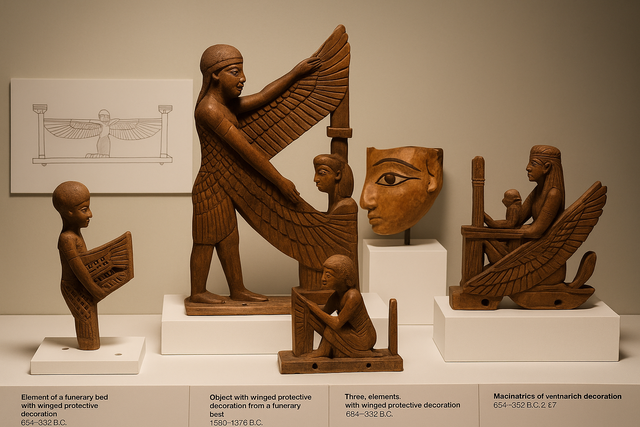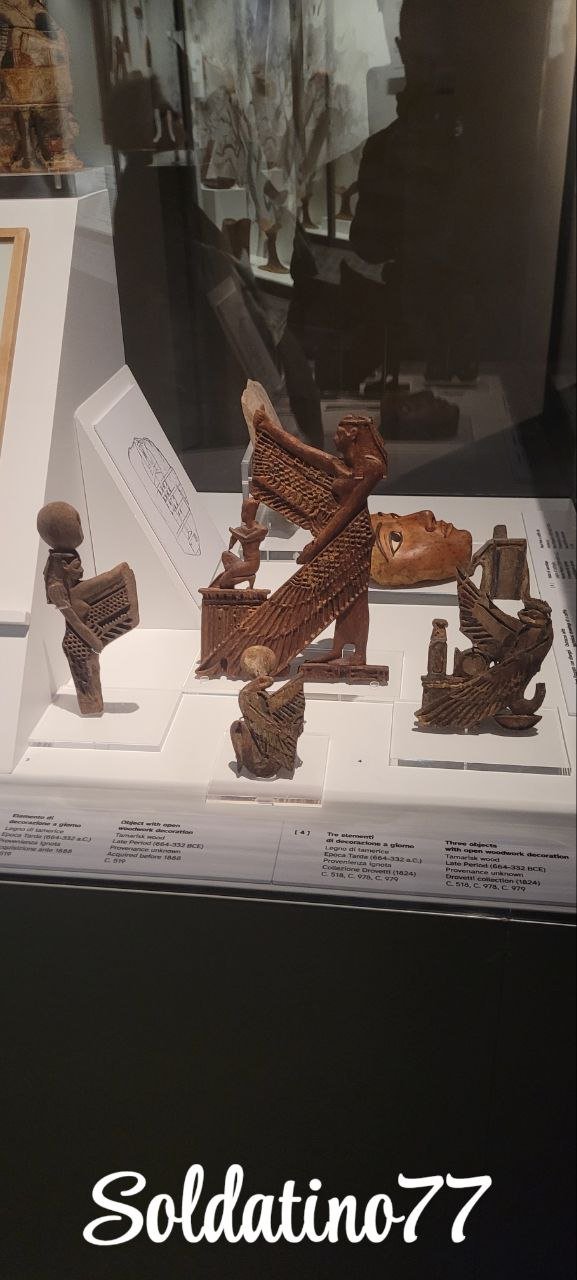
L'immagine in figura mostra un insieme di elementi decorativi lignei che facevano parte di un arredo funerario, probabilmente un letto rituale o una barella utilizzata per la mummia o una statua sacra.
Questi manufatti sono intagliati nel legno, rappresentano ali piumate e figure femminili alati inginocchiate. La funzione originaria era quella di decorare i lati di arredi funebri, come letti sacri o barelle cerimoniali. Nell’iconografia egizia, le ali simboleggiano protezione divina, spesso attribuita alle dee come Iside e Nefti, e all’idea di ordine cosmico (Maat).
Le figure scolpite sono elegantemente stilizzate, con attenzione al piumaggio e alla postura protettiva. I fori alla base suggeriscono che erano fissate perpendicolarmente alla struttura del letto o del supporto.

Questi elementi risalgono a un periodo compreso tra il Terzo Periodo Intermedio e l’Epoca Tarda (circa 943–332 a.C.). In quel tempo, l'arredamento funerario assumeva un forte significato rituale: piume e ali erano associate alla resurrezione e alla leggerezza dell’anima, oltre a richiamare la figura di Khepri, lo scarabeo alato simbolo del sole nascente e della rinascita.
Più che oggetti estetici, queste decorazioni erano strumenti magici: evocavano protezione, stabilità, rispetto dell’ordine cosmico e assistenza all’anima del defunto nell’aldilà.
Quale dettaglio vi colpisce di più? L’eleganza delle decorazioni piumate o l’idea della protezione divina attraverso queste ali? Scrivete nei commenti e lasciate un like se vi incuriosisce il simbolismo funerario egizio! 🪶🏺✨
La prima fotografia l' ho creata con l'intelligenza artificiale, mentre la seconda l ho scattata personalmente al Museo Egizio 📸🕵🏻♂️🏛️
Traduzione in inglese 🇬🇧

The image shows a collection of wooden decorative elements that were part of a funerary furnishing, probably a ritual bed or a stretcher used for a mummy or a sacred statue.
These artifacts are carved in wood and depict feathered wings and kneeling winged female figures. Their original function was to decorate the sides of funerary furnishings, such as sacred beds or ceremonial stretchers. In Egyptian iconography, wings symbolized divine protection, often associated with goddesses like Isis and Nephthys, and the concept of cosmic order (Maat).
The carved figures are elegantly stylized, with careful attention to the feathers and protective posture. The holes at the base suggest they were fixed perpendicularly to the structure of the bed or support.

These elements date back to a period between the Third Intermediate Period and the Late Period (circa 943–332 BCE). At that time, funerary furnishings carried strong ritual significance: feathers and wings were associated with resurrection and the lightness of the soul, as well as with the figure of Khepri, the winged scarab symbolizing the rising sun and rebirth.
More than aesthetic objects, these decorations were magical tools: they evoked protection, stability, respect for cosmic order, and assistance to the soul of the deceased in the afterlife.
What detail strikes you the most? The elegance of the feathered decorations or the idea of divine protection through these wings? Share your thoughts in the comments and leave a like if you're intrigued by Egyptian funerary symbolism! 🪶🏺✨
The first image was created using artificial intelligence, while the second was taken personally by me at the Egyptian Museum. 📸🕵🏻♂️🏛️
che belli i reperti egizi , mi affascina molto la loro storia !
Downvoting a post can decrease pending rewards and make it less visible. Common reasons:
Submit
Bene, son contento! Anche a me affascina molto, è una civiltà davvero misteriosa e ricca di storia.
Grazie per il tuo commento
Downvoting a post can decrease pending rewards and make it less visible. Common reasons:
Submit
Downvoting a post can decrease pending rewards and make it less visible. Common reasons:
Submit